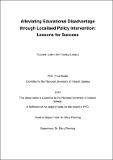| dc.description.abstract | Educational disadvantage, recognised as a factor in determining a child's life-chances, manifests itself in the form of resistance to and disengagement from school, resulting in the inability of marginalised students to derive full benefit from the education system (McKeown & Clarke, 2004; Kellaghan, 2001; Education Act, 1998). Although inclusion of the 'student voice' is becoming more common in the decision-making process in schools, students from lower socio-economic backgrounds have limited opportunities to participate in processes of education reform in their schools.
Engaging students experiencing marginalisation as active participants in an intervention such as the Student Engagement Programme (SEP), which is designed and adapted through understanding the students' social contextualisation, is a process that requires examining their everyday lived experiences and determining how these experiences have contributed and continue to contribute to the students' personal and educational development.
This research examined the process of engaging marginalised students as they participated in the SEP, and then assessed the resulting outcomes for the students and the school.
The research is informed by two theories: critical theory, which supports the framework of action research, where through collective participation a 'grassroots' agenda for change and development can be established, and Bourdieuian Cultural Reproduction Theory, which scaffolds the aims of SEP, where, through a student-focused inquiry and student participation in the programme, students can develop their skills in academic areas and build their skills and capacity for dealing with socially related difficulties.
The principal findings from this research are that, for localised initiatives to help alleviate educational disadvantage and thus enable better outcomes and life-chances of the students, the programme must actively include the 'student voice' through exploring the process of the students' engagement and the outcomes of their engagement. | en_US |
| dc.local.note | Educational disadvantage, recognised as a factor in determining a child's life chances, manifests itself in the form of resistance to and disengagement from school, resulting in the inability of marginalised students to derive full benefit from the education system. Jude Lohan found that, engaging marginalised students through a student-focused localised intervention and process of educational reform creates an effective forum for improving their engagement and retention in school, resulting in their ability to secure better life chances. | en_US |


